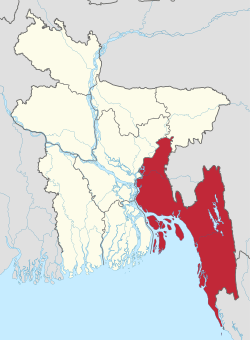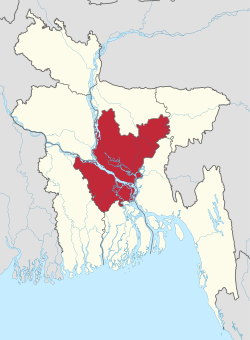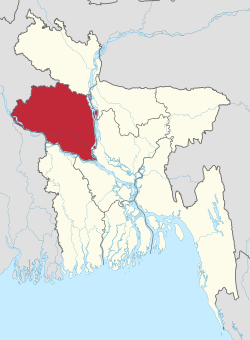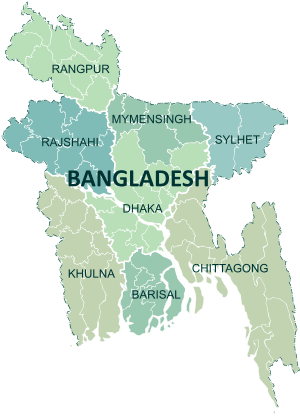Sylhet Division
Sylhet Division (Bengali: সিলেট বিভাগ) is the northeastern division of Bangladesh. It is bordered by the Indian states of Meghalaya, Assam and Tripura to the north, east and south respectively, and by the Bangladeshi divisions of Chittagong to the southwest and Dhaka and Mymensingh to the west. Along with the Indian district of Karimganj, it forms the Greater Sylhet region.
Sylhet Division সিলেট বিভাগ | |
|---|---|
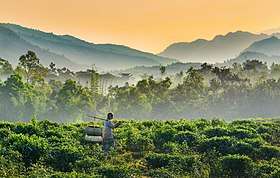   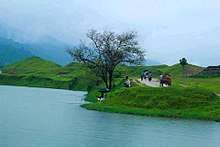  .jpg) 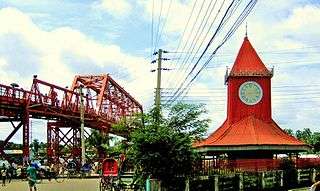 Clockwise from top Jaflong, Ratargul Swamp Forest, Tanguar Haor, Keane Bridge & Ali Amjad's Clock, Shrine of Shah Jalal, Jadukata River, and Malnicherra Tea Estate. | |
 Map of Sylhet Division | |
| Coordinates: 24°30′N 91°40′E | |
| Country | |
| Capital | Sylhet |
| Area | |
| • Total | 12,298.4 km2 (4,748.4 sq mi) |
| Population (2016) | |
| • Total | 12,102,325 |
| • Density | 980/km2 (2,500/sq mi) |
| Demonym(s) | Sylheti |
| Demographics | |
| • Literacy rate | 51%[1] |
| Languages | |
| • Official language | Bengali[2] |
| • Spoken languages | • Sylheti[3]
• Meitei • Khasi • Bishnupriya Manipuri • Hindi |
| Time zone | UTC+6 (BST) |
| ISO 3166 code | BD-G |
| HDI (2017) | 0.558[4] medium |
| Notable cricket teams | • Sylhet Division cricket team • Sylhet Sixers |
| Website | sylhetdiv |
Sylhet is an archaeologically ancient region of South Asia, and has a rich history of Hindu, Buddhist and Islamic culture. There are number of Hindu, Sufi and Muslim religious sites found in this division.
Etymology
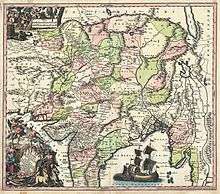
The name Sylhet is an anglicisation of Shilhot (শিলহট). Its origins seem to come from the Sanskrit words of शिला śilā (meaning stone) and हट्ट haṭṭa (meaning marketplace). These words match the landscape and topography of the hilly region. The shila stones were abundant across Sylhet and King Gour Govinda is known to have used stones to guard his capital. The word changed to Shilhot due to the elision of letter-final অ ô in the Bengali language.[5] Mughal documents such as the Ain-i-Akbari referred to the region in Persian as Silhet/Silhat (سلهت). Archaic European names included Sirote and Silhat. After the British arrived in the region in the 18th century, the spelling was changed to Sylhet so that it is distinct from the name of the nearby town of Silchar. In Modern Standard Bengali, the official name is Śileṭ (সিলেট). Another less-common endonym is Siloṭ (ꠍꠤꠟꠐ/ছিলট).[6]
An alternative name which may or may not have originated from Shilahatta was Srihatta (श्रीहट्ट) or Srihotto (শ্রীহট্ট). The word sri is a Sanskrit word for beauty. This name was used in Kamarupa and the other petty kingdoms. In the Bengal Sultanate's inscriptions, Srihat/Sirhat (سریحت/سرحت) can be found as an administrative "Arsah". The earliest Sultanate inscription using this name was found in Shah Jalal's dargah. Dating 1303, the inscription mentions Sikandar Khan Ghazi's Conquest of Arsah Srihat with the help of Shah Jalal, during the reign of Sultan Shamsuddin Firoz Shah.[7]
Another theory is that the word is of Semitic origin and compares it to the Hebrew word שלט shelet. According to Hebrew researchers, the word shelet is used when something is guaranteed or protected. The word shelet has been used in the Hebrew Bible to mean shield or ruler.[8] However, there is no clear evidence that the name is derived from this.
After the Islamic Conquest of Sylhet in 1303, a popular nickname of the city was Jalalabad (জালালাবাদ). It is made up two words Jalal (جلال), a name of Arabic origin meaning majesty but in this case referring to Shah Jalal, and Abad (آباد), meaning settlement.[9][10][11] Currently, in the Sylhet City Corporation, there exists a metropolitan thana known as the Jalalabad Thana as well an area in its 7th ward.[12]
History
In 1874, the current Sylhet Division, along with Karimganj, was known as the 'Sylhet district'. In September of the same year, Sylhet was separated from mainland Bengal to be made a part of the non-regulation Chief Commissioner's Province of Assam (Northeast Frontier Province) in order to facilitate Assam's commercial development.[13][14] The people of Sylhet submitted a memorandum to the Viceroy protesting the inclusion in Assam.[15] The protests subsided when the Viceroy, Lord Northbrook, visited Sylhet to reassure the people that education and justice would be administered from Bengal,[16] and when the people in Sylhet saw the opportunity of employment in tea estates in Assam and a market for their produce.[17] In 1905, Sylhet district rejoined Bengal as a part of the new Surma Valley Division of Eastern Bengal and Assam. In 1912, the then Sylhet district was moved to the newly-created Assam Province alongside the other districts of the Surma Valley Division.
In 1947, a referendum was held in the Sylhet district, voting in favour of succession to Pakistan. However, the district's Karimganj subdivision was given to India after being pleaded by a delegation led by Abdul Matlib Mazumdar. The modern-day Sylhet Division was known as the Sylhet district in Pakistan. In 1971, Sylhet became part of the newly formed independent country of Bangladesh but remained in the Chittagong Division until 1995.
The Sylhet region has a "friendship link" with the city of St Albans, in the United Kingdom. The link was established in 1988 when the St Albans District Council supported a housing project in Sylhet as part of the International Year of Shelter for the Homeless. Sylhet was chosen because it is the area of origin for the largest ethnic minority group in St Albans.[18]
Sylhet also has many "friendship links" with other cities in the United Kingdom, as majority of the half-million British Bangladeshis have origins in Sylhet. This includes places such as Rochdale, Oldham, London, and many more places.
Economy
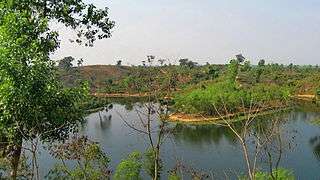
The area around Sylhet is a traditional tea growing area. The Surma Valley is covered with terraces of tea gardens and tropical forests. Srimangal is known as the tea capital of Bangladesh; for miles around, tea gardens are visible on the hill slopes.
The area has over 150 tea gardens, including three of the largest tea plantations in the world, both in terms of area and production. Nearly 300,000 workers, of which more than 75% are women, are employed on the tea estates. Employers prefer to engage women for plucking tea leaves since they do a better job than, but are paid less than, men. A recent drought has killed nearly a tenth of the tea shrubs.
The plantations, or gardens, were mostly developed during the British Raj. The plantations were started by the British, and the managers still live in the white timber houses built during the Raj. The bungalows stand on huge lawns. The service and the lifestyle of managers are still unchanged.
Numerous projects and businesses in the city and in large towns have been funded by Sylhetis living and working abroad. As of 1986, an estimated 95 percent of ethnic British Bangladeshis originated from or had ancestors from the Sylhet region.[19] The Bangladesh government has set up a special Export Processing Zone (EPZ) in Sylhet, in order to attract foreign investors, mainly from the UK.
Sylhet has also benefited from tourism. There are many natural landmarks people tend to visit, such as the Keane Bridge, Ali Amjad's Clock, Lalakhal, Jaflong, Madhabkunda waterfall, Ratargul Swamp Forest, Hakaluki Haor, Lawachara National Park, and Bichnakandi. Sylhet is also considered to be the spiritual capital of Bangladesh, due to the resting place of Shah Jalal, a Sufi saint who spread Islam in Bangladesh, along with hundreds of his disciples. The Sylhet Shahi Eidgah is a famous place where Eid prayers take place and it is one of the largest Eidgahs in Bangladesh, built by Farhad Khan during the reign of Mughal emperor Aurangzeb. There are a number of hotels and resorts, particularly in Sreemangal Upazila and Bahubal Upazila.
Governance
In 1995, Sylhet was declared the 6th division of the country. Prior to that it was part of the Chittagong Division. The Sylhet Division is subdivided into four districts (zillah): Habiganj, Moulvibazar, Sunamganj and Sylhet. Further, the Sylhet Division contains 35 sub-districts (upazila/thana), 323 union parishad, 10,185 villages and 14 municipalities. Population: approximately 10 million, which is less than 7% of the total population of Bangladesh.
| Name | Capital | Area (km2)[20] | Population 1991 Census | Population 2001 Census | Population 2011 Census |
|---|---|---|---|---|---|
| Habiganj District | Habiganj | 2,536.58 | 1,526,609 | 1,757,665 | 2,089,001 |
| Moulvibazar District | Moulvibazar | 2,601.84 | 1,376,566 | 1,612,374 | 1,919,062 |
| Sunamganj District | Sunamganj | 3,669.58 | 1,708,563 | 2,013,738 | 2,467,968 |
| Sylhet District | Sylhet | 3,490.40 | 2,153,301 | 2,555,566 | 3,434,188 |
| Total District | 4 | 12,298.4 | 6,765,039 | 7,939,343 | 9,910,219 |
| District | Upazila | ||||||
|---|---|---|---|---|---|---|---|
| Habiganj District |
| ||||||
| Moulvibazar District | |||||||
| Sunamganj District | |||||||
| Sylhet District | |||||||
Geography

Geographically, Sylhet division is surrounded by hillocks (known as tillas) from all three sides except its western plain boundary with the rest of Bengal. In the south of the region (Habiganj and Moulvibazar), eight hill ranges enter the plains of Sylhet running uniformly from the west to the east. They are: Raghunandan, Dinarpur-Shatgaon, Balishira, Bhanugach-Rajkandi, Hararganj-Singla, Patharia, Pratapgarh-Duhalia and Sorrispur-Siddheswar hill ranges. At the centre of the region is also an isolated range known as the Ita Hills.[21]
The division is considered one of the most picturesque and archaeologically rich regions in South Asia. It is home to three national parks; the Lawachara National Park, Khadim Nagar National Park and Satchari National Park, as well as numerous smaller parks and forests such as the Ratargul Swamp Forest, Rema-Kalenga Wildlife Sanctuary. Its burgeoning economy has contributed to the regional attractions of landscapes filled with fragrant orange and pineapple gardens as well as tea plantations. The region has a tropical monsoon climate (Köppen Am) bordering on a humid subtropical climate (Cwa) at higher elevations. The rainy season from April to October is hot and humid with very heavy showers and thunderstorms almost every day, whilst the short dry season from November to February is very warm and fairly clear. Nearly 80% of the annual average rainfall of 4,200 millimetres (170 in) occurs between May and September.[22]
The physiography of the division consists mainly of hill soils, encompassing a few large depressions known locally as "beels" which can be mainly classified as oxbow lakes, caused by tectonic subsidence primarily during the earthquake of 1762.
Geologically, the division is complex having diverse sacrificial geomorphology; high topography of Plio-Miocene age such as the Khasi and Jaintia Hills and small hillocks along the border. At the centre there is a vast low laying flood plain of recent origin with saucer shaped depressions, locally called haors. There are many haors in the region and the largest ones include Hakaluki, Kawadighi, Tanguar and Hail. Available limestone deposits in different parts of the region suggest that the whole area was under the ocean in the Oligo-Miocene. In the last 150 years, three major earthquakes hit the city, at a magnitude of at least 7.5 on the Richter Scale, the last one took place in 1918, although many people are unaware that Sylhet lies on an earthquake prone zone.[23]

Flora and fauna
The region is home to the Asian elephant and the One-horned rhinoceros, mostly towards the south. Tigers and leopards were once found throughout the region. Other notable fauna include the Sambar deer, Indian hog deer, Sylhet hara and Sylhet roofed turtle.[24]
The Asian elephant were once found in small numbers in places such as Chapghat, Bhanugach, Chamtolla, Mahram and the Raghunandan hills. More abundantly they are found near streams in Singla and Langai.[21]
Culture
Language
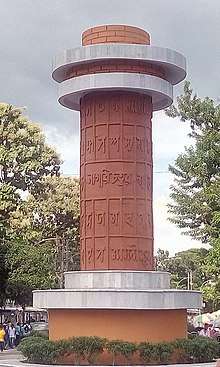
The official language of Sylhet is Bengali. It is used in education and all government affairs in the division. The most common spoken language is Sylheti which is generally and officially considered as a dialect of Bengali.[25] The Adivasis and tea labourers brought over during the British colonial rule also have their own native languages such as Khasi, Kuki, Laiunghtor, Meitei, Bishnupriya Manipuri, Hajong, Garo, Odia, Kurmi creole, Hindi, Bhumij and Tripuri.[26]
Architecture
The intense building of mosques which took place during the Sultanate era indicates the rapidity with which the locals converted to Islam. Today, mosques are present in every Muslim-inhabited village. Bengali mosques are normally be covered with several small domes and curved brick roofs decorated with terracotta. Ponds are often located beside a mosque.[27]
Faujdar Farhad Khan built Sylhet Shahi Eidgah in the 1660s under the reign of Mughal Emperor Aurangzeb. It stands as the largest eidgah of the region.[28]
In 1872, Nawab Moulvi Ali Ahmed Khan of Prithimpassa constructed Ali Amjad's Clock, named after his son, in Sylhet City.[29][30][31] In 1936, a bridge was constructed across the Surma River known as the Keane Bridge. These two historic landmarks are known as the gateway to Sylhet city.
Assam-type architecture developed in Sylhet region under Assam Province during the late modern period.
- Architecture of Sylhet

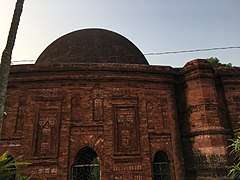
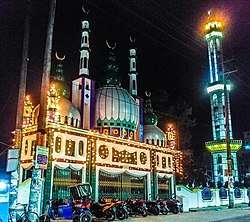 Sylhet Shahi Eidgah entrance
Sylhet Shahi Eidgah entrance Modern architecture in Sylhet
Modern architecture in Sylhet
Sports and games

Cricket is the most popular sport in Sylhet. Regional cricket teams include Sylhet Thunder, East Zone and the Sylhet Division cricket team. The Government Boys' HS School Ground is a historical cricket ground in Karimganj. Football is also a common sport and the multi-use Saifur Rahman Stadium and Netaji Subhas Chandra Bose Stadiums are known to host football matches. Beanibazar SC has played in the Bangladesh League. The home stadium of the football club, Sheikh Russel KC, is in Sylhet District Stadium. In 1897, the Cachar Club based in Silchar developed the modern version of Polo and introduced it to the Englishmen. It was also the first ever polo club in the world.[32] Board and home games such as Fochishi and its modern counterpart Ludo, as well as Carrom Board, Sur-Fulish, Khanamasi and Chess, are very popular in the region. Nowka Bais is a common traditional rowing competition during the monsoon season when rivers are filled up, and much of the land is under water. Fighting sports include Kabaddi, Latim and Lathi khela.
Demography
Religion
Religion in Sylhet
Sylhet is a holy place for both Muslim and Hindus. Historically it is known as the land of 360 awliyas (Muslim saints). Famous religious places include the shrines of Shah Jalal, Shah Farhan (popularly known as Shah Paran), Shah Kamal Quhafa in Shaharpara, Shah Mustafa in Moulvibazar and Syed Nasiruddin in Chunarughat for Muslims.[33]
Sylhet has the largest concentration of Hindus in Bangladesh and is historically an important centre for believers. It is part of the global Shakti Peethas, holy places of cosmic and enormous power, where Goddess Durga is worshipped. Of the fifty-one body parts of Sati, one form of Durga, that fell on Earth, Her neck fell on the south side of Surma River across the Sylhet town and her left palm fell in Jayanti. In addition, Sri Krishna Chaitnaya Mahaprabhu, the God of all Humanity and who will reappear during the kaliyug or end of time, visited his paternal family home in Thakurbari, Dhakadakshin, Golapganj and his maternal family home in Joypur, Habiganj in Sylhet Division in the 16th century. Hindu temples, such as Shri Chaitanya Dev Mandir in Dhakadakshin, Kali Mandir of Jainpur, Narayan Shiva Mandir of Khasa Pandith Para of BeaniBazar, Sri Mahaprabhu Bigraha Akhra of Jaldhup in Beanibazar, Shakti Piths temple of Kirit Devi Kamala, Bagala Matar Mandir of Habiganj, and Kalibari of Jaintiapur are popular.[34]
Followers of different religions are: Muslim 85.50%, Hindu 13.00%, Christian 0.05%, Buddhist 0.02%, and others 0.80%. There are 7524 mosques, 1070 temples, 65 churches, 2 sacred place, 9 pagodas, 50 tomb.

Notable people
In popular culture
- In season 4, episode 6, of Call the Midwife, the midwives tend to a woman from the Sylhet Division.[35]
See also
- Sylhetis
- Sylheti language
- Sylheti Nagari script
- Sylhet roofed turtle
- Sylhet Hara
- Hatkhora
References
- "Illiteracy curses half in Sylhet". www.daily-bangladesh.com (in Bengali).
- "Article 3. The state language". The Constitution of the People's Republic of Bangladesh. bdlaws.minlaw.gov.bd. Ministry of Law, The People's Republic of Bangladesh. Retrieved 1 February 2017.
- "Sylheti". Ethnologue.
- "Sub-national HDI - Area Database - Global Data Lab". hdi.globaldatalab.org. Retrieved 13 September 2018.
- Rabbani, AKM Golam (7 November 2017). "Politics and Literary Activities in the Bengali Language during the Independent Sultanate of Bengal". Dhaka University Journal of Linguistics. 1 (1): 151–166. Retrieved 7 November 2017 – via banglajol.info.
- "About the name Srihatta". Srihatta.com.bd. Retrieved 7 April 2019.
- Ahmad Hasan Dani (1957). "Analysis of the Inscriptions". Asiatic Society Of Pakistan Vol-ii. p. 111.
- Shofi Ahmed. "'Shelet' (Sylhet) Found in the Bible". Bangla Mirror.
- Abu Musa Mohammad Arif Billah (2012). "Persian". In Sirajul Islam and Ahmed A. Jamal (ed.). Banglapedia: National Encyclopedia of Bangladesh (Second ed.). Asiatic Society of Bangladesh.
- Sylhet City. Bangla2000. Retrieved 28 November 2008.
- Sufia M. Uddin. Constructing Bangladesh: Religion, Ethnicity, and Language in an Islamic Nation. p. 148.
- Hussain, M Sahul (2014). "Jalalabad Thana". Banglapedia: National Encyclopedia of Bangladesh (Second ed.). Asiatic Society of Bangladesh.
- Tanweer Fazal (2013). Minority Nationalisms in South Asia. Routledge. pp. 53–54. ISBN 978-1-317-96647-0.
- "To make (the Province) financially viable, and to accede to demands from professional groups, (the colonial administration) decided in September 1874 to annex the Bengali-speaking and populous district of Sylhet."(Hossain 2018:260)
- " A memorandum of protest against the transfer of Sylhet was submitted to the viceroy on 10 August 1874 by leaders of both the Hindu and Muslim communities." (Hossain 2013:261)
- "It was also decided that education and justice would be administered from Calcutta University and the Calcutta High Court respectively." (Hossain 2013:262)
- "They could also see that the benefits conferred by the tea industry on the province would also prove profitable for them. For example, those who were literate were able to obtain numerous clerical and medical appointments in tea estates, and the demand for rice to feed the tea labourers noticeably augmented its price in Sylhet and Assam enabling the Zaminders (mostly Hindu) to dispose of their produce at a better price than would have been possible had they been obliged to export it to Bengal." (Hossain 2013:262)
- Sylhet, Bangladesh Archived 19 June 2009 at the Wayback Machine.St.Albans District Council.
- Gardner, Katy (July 1992). "International migration and the rural context in Sylhet". New Community. 18 (4): 579–590. doi:10.1080/1369183X.1992.9976331.
- Sajahan Miah (2012). "Sylhet Division". In Sirajul Islam and Ahmed A. Jamal (ed.). Banglapedia: National Encyclopedia of Bangladesh (Second ed.). Asiatic Society of Bangladesh.
- E M Lewis (1868). "Sylhet District". Principal Heads of the History and Statistics of the Dacca Division. Calcutta: Calcutta Central Press Company. pp. 281–326.
- Monthly Averages for Sylhet, BGD MSN Weather. Retrieved 25 May 2009.
- Siddiquee, Iqbal (10 February 2006). "Sylhet growing as a modern urban centre". The Daily Star. Retrieved 25 May 2009.
- B C Allen (1905). Assam District Gazetteers. 2. Calcutta: Government of Assam.
- Niharranjan Ray (January 1980). Bangalir Itihas (in Bengali). 2.
- Jengcham, Subhash. "Mushahar". Banglapedia: National Encyclopedia of Bangladesh. Asiatic Society of Bangladesh.
- Oleg Grabar (1989). Muqarnas: An Annual on Islamic Art and Architecture. Brill Archive. pp. 58–72. ISBN 978-90-04-09050-7.
- Ali Ahmad. "Vide". Journal of Assam Research Society. VIH: 26.
- Kadir Jibon, Abdul (11 September 2018). "Ali Amjad's Tower Clock". Daily Sun. Dhaka. Retrieved 17 August 2019.
- Alam, Mahabub (20 July 2016). এখনও সময় জানায় আমজাদের সেই ঘড়ি [Ali Amjad's clock still telling the time!]. Banglanews24.com (in Bengali). Retrieved 18 August 2019.
- Chowdhury, Aftab (5 October 2016). আলী আমজাদের ঘড়ি [The Clock of Ali Amjad]. Bangaldesh Pratidin (in Bengali). Dhaka. Retrieved 18 August 2019.
- http://www.cacharclub.in
- Sylhet Itibritta, Syed Mujtaba Ali
- "Bangladesh – The Holy Land of Hindu and Buddhist Pilgrim=". Indo Link.
- "'Call The Midwife' Season 4 Premiere: Nurse Barbara Learns About Culture As Cynthia Returns In Sneak Peek [VIDEO]". ENSTARZ.
External links
| Wikivoyage has a travel guide for Sylhet Division. |


